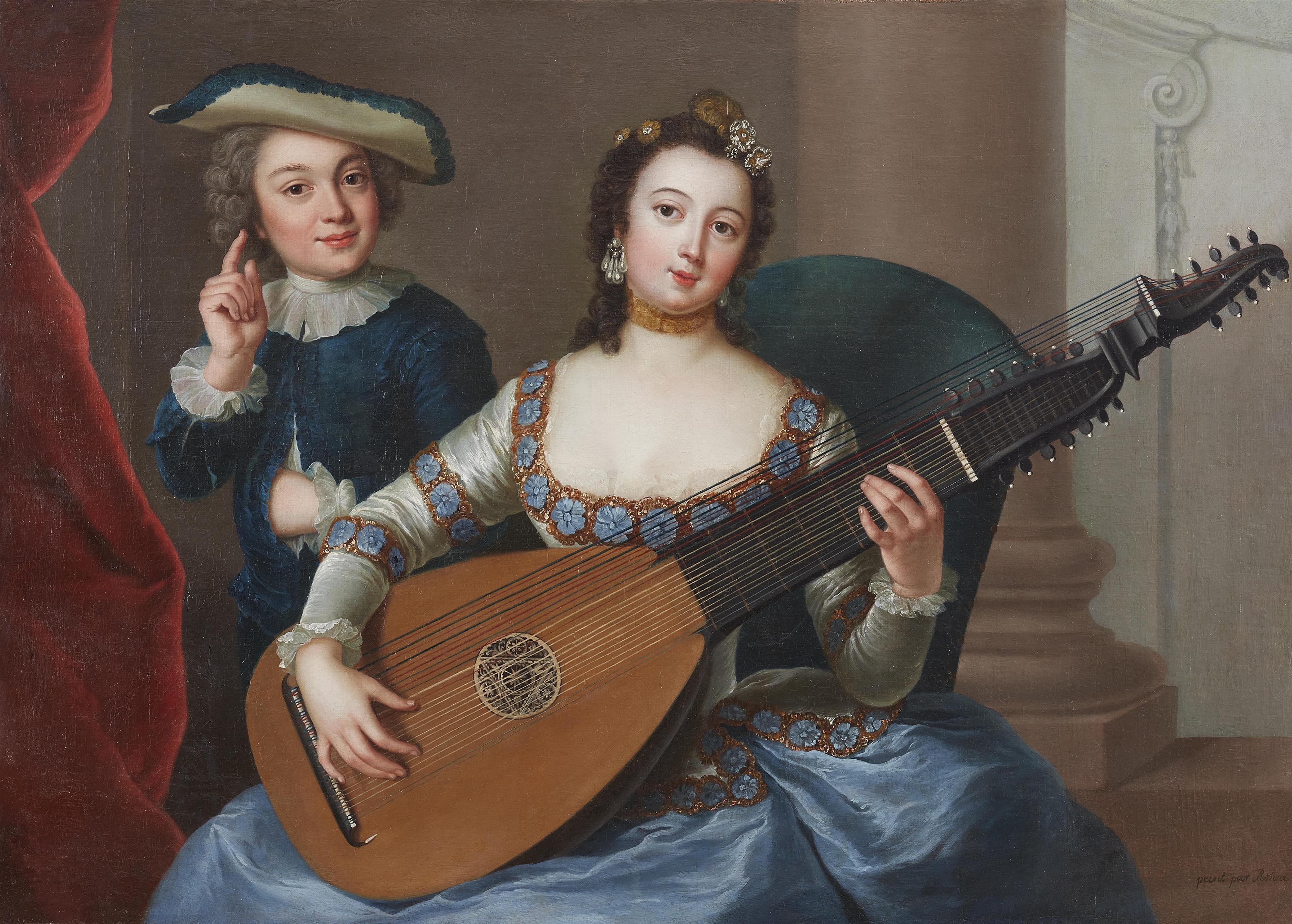Barbara Rosina Lisiewska-de Gasc
Allegory of the sense of hearing
Oil on canvas (relined). 96 x 134 cm.
Framed with gilded wooden frame (106.5 x 143 cm).
Signed lower right: peint par Rosine.
Berlin, at the beginning of the 18th century, the art scene was still small, but developed rapidly and - surprisingly - with the participation of female artists. Anna-Rosina Lisiewski and her 8 years younger sister Anna Dorothea, later married Therbusch, were the most significant protagonists.
Born in 1713 as the third child of the portrait painter Georg Lisiewsky, who worked at court, she was part of the Berlin art scene from the very beginning. Three years earlier, Antoine Pesne had taken up his position as court painter here. He was to remain so during the reigns of three kings and was to be the centre of the art world in Berlin and Potsdam for a very long time. Georg Lisiewsky initially taught both daughters himself, as the art academy was not open to women. Antoine Pesne continued their education. Anna-Rosina remained particularly attached to this young 18th century art scene, so much so that she even turned down a call to Dresden in 1734. She did not want to give up the studio partnership with her father just yet. Instead, she forged even closer ties with Berlin's painters when she married the Prussian court painter David Matthieu in 1741.
Anna-Rosina Lisiewsky also found the models for her portrait paintings at the Prussian court. These were mainly members of the high nobility, but she also paid attention to other female artists. In a group portrait entitled "Galante Gesellschaft", she depicts herself and the ballerina Barbara Campanini, also known as "Barbarina", alongside Margrave Friedrich Heinrich and Margravine Leopoldine Marie von Brandenburg-Schwedt(private collection). She is a star of cultural and social life. She made her debut at the royal opera in 1744, having been poached by Frederick II from her engagement in Paris and during a tour, and became the best-paid artist in Prussia. The "Flying Goddess", as Barbara Campanini was known not only in Berlin, modelled for various painters as a stage star: Rosalba Carriera was probably the first to paint her, and still in Paris. A new portrait by the Prussian court engraver Georg Friedrich Schmidt was recently identified in Berlin. It does not show her dancing, but holding a musical instrument, a tambourine. The model for this was the large, elaborately staged portrait that Antoine Pesne painted for Sanssouci Palace on behalf of the king. It depicts "Barbarina" in a garden in a prancing pose, accompanied by a young man with a bagpipe in the background.
Anna-Rosina Lisiewsky's light-footed movement between portrait painting and genre-like insights into courtly life also characterises the present allegory of the sense of hearing. The lady with the lute is probably once again the famous "Barbarina" - or at least inspired by her. The fine facial features, the dark hair and the brown eyes, but above all the dress with the appliquéd flowers, which can be seen in a very similar way in all the portraits of the Campanini, suggest this. Here she has taken over the instrument herself. With the theorbo in her hand, an extended form of a baroque lute, she sets the tone and plays the leading role in Lisiewsky's composition. In doing so, she has attracted the attention of a young man in the background. Both are looking directly at the viewer. The gesture of his right hand not only refers to the theme of listening, it is also an invitation. At least to listen - but perhaps also to join in with the harmony and turn the forthcoming duet between the two into a trio, as the theorbo was often used as an accompanying instrument for singing. Parties held in "Barbarina's" flat near today's Pariser Platz have been recorded. Here the portrait painter demonstrates her own ability, honed over the course of her career, to capture her subjects sensitively and visualise their characteristic features.
Provenance
Auction Frederik Muller & Co, Amsterdam 25/28 February 1941, lot 822 - Dr Sigmund Wassermann, Amsterdam. - C.F. van Veen, Amsterdam (on behalf of Dr Wassermann). - Gallery de Boer, Amsterdam. - Nuremberg Municipal Museum. - Handed over to the Dutch state after the 2nd World War. - Museum Het Markiezenhof, Bergen op Zoom (on loan from the Dutch state). - Restituted to the heirs of Dr Sigmund Wassermann in 2008. - Sotheby's, London 5 Dec. 2013 - German private collection.

